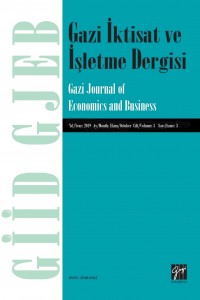Öz
This
study analyzes the neoclassical theory on the demand for children. Neoclassical
theory assumes that child demand is not different from a commodity demand. The
neoclassical theory takes child demand in the utility function, like any other
commodities. But, the demand for children is different from things which
increase our utility; such as car, refrigerator, elevator, and other goods and
services, whose price is determined in the market through its sellers and
buyers. However, demand for children is determined by socio-cultural things. It
is certain that there is a relationship between economic growth and child
rearing. For example, economic growth raises the cost of children due the time
spent on child care becoming more valuable. But it cannot be called "child
demand is an inferior good".
Anahtar Kelimeler
Demand for children desired family size Neo-classical approach economic growth
Kaynakça
- Becker, G.S. (1960). An Economic Analysis of Fertility, nber.http://www.nber.org/chapters/c2387.pdf
- Becker, G. & Tomes, N. (1976). Child Endowments and Quantity and Quality of Children. The Journal of Political Economy, Vol: 84, No: 4, 143-162.
- Blake, J. (1968). Are Babies Durables? A Critic of the Economic Theory of Reproductive Motivation. Population Studies, Vol: 22, No: 1, 5-25.
- Caplan, B. (2006). Terrorism: The relevance of the rational choice model. Public Choice, 91-107. (http://econfaculty.gmu.edu/bcaplan/pdfs/terrorism.pdf)
- Cochrane, S.H. (1975). Children as By-products, Investment Goods and Consumer Goods: A review of Some Micro-economic Models of Fertility. Population Studies, Vol: 29, No: 3, 373-390.
- Dixon-Mueller, R. (1993). Population policy & women's rights: Transforming reproductive choice. Westport, Connecticut: Praeger.
- Folbre, N. (1984). Household production in Philippinnpes: A Non-Neoclassical Approach. Economic Development and Culture Change, Vol:32, No:2, 303-330.
- Leibenstein, H. (1974). An interpretation of the economic theory of fertility: Promising path or blind alley?. Journal of Economic Literature, 12, no. 2 (June): 457-479.
- Lucas, R.E., Jr. (1988). On the Mechanics of Economic Development, Journal of Monetary Economics, Vol. 22, No.4, pp. 3-42.
- Romer, P. M. (1990). Endogenous Technological Change. Journal of Political Economy, Vol. 98, No.5, pp. 71-102.
- Romer, P. M. (1994). The Origins of Endogenous Growth. The Journal of Economic Perspectives, Vol. 8, No.1, pp. 3-22.
Öz
çalışma neoklasik teoriyi çocuk talebi üzerine analiz etmektedir. Neoklasik
teori çocuk talebinin herhangi bir mal talebinden farksız olduğunu
varsaymaktadır. Bu bakış açısından hareketle çocuk talebi, diğer tüm mallar
gibi, fayda fonksiyonu içerisine dahil edilir. Ne var ki çocuk talebi faydamızı
artıran araba, buzdolabı, asansör ve diğer mal ve hizmetlerden farklıdır, zira
bu tür malların fiyatları piyasada satıcılar ve alıcılar tarafından belirlenir.
Çocuk talebi ise sosyo-kültürel gerçeklikler tarafından tayin edilir. Ekonomik
büyüme ve çocuk yetiştirme arasında bir ilişki olduğu muhakkaktır. Örneğin,
iktisadi büyümeyle birlikte çocuğa ayrılan vakit daha değerli hale geldiği için
çocuk maliyetini de artırmıştır. Yine de bu sonuç çocuk talebinin bir düşük mal
olduğunu göstermez.
Anahtar Kelimeler
Kaynakça
- Becker, G.S. (1960). An Economic Analysis of Fertility, nber.http://www.nber.org/chapters/c2387.pdf
- Becker, G. & Tomes, N. (1976). Child Endowments and Quantity and Quality of Children. The Journal of Political Economy, Vol: 84, No: 4, 143-162.
- Blake, J. (1968). Are Babies Durables? A Critic of the Economic Theory of Reproductive Motivation. Population Studies, Vol: 22, No: 1, 5-25.
- Caplan, B. (2006). Terrorism: The relevance of the rational choice model. Public Choice, 91-107. (http://econfaculty.gmu.edu/bcaplan/pdfs/terrorism.pdf)
- Cochrane, S.H. (1975). Children as By-products, Investment Goods and Consumer Goods: A review of Some Micro-economic Models of Fertility. Population Studies, Vol: 29, No: 3, 373-390.
- Dixon-Mueller, R. (1993). Population policy & women's rights: Transforming reproductive choice. Westport, Connecticut: Praeger.
- Folbre, N. (1984). Household production in Philippinnpes: A Non-Neoclassical Approach. Economic Development and Culture Change, Vol:32, No:2, 303-330.
- Leibenstein, H. (1974). An interpretation of the economic theory of fertility: Promising path or blind alley?. Journal of Economic Literature, 12, no. 2 (June): 457-479.
- Lucas, R.E., Jr. (1988). On the Mechanics of Economic Development, Journal of Monetary Economics, Vol. 22, No.4, pp. 3-42.
- Romer, P. M. (1990). Endogenous Technological Change. Journal of Political Economy, Vol. 98, No.5, pp. 71-102.
- Romer, P. M. (1994). The Origins of Endogenous Growth. The Journal of Economic Perspectives, Vol. 8, No.1, pp. 3-22.
Ayrıntılar
| Birincil Dil | İngilizce |
|---|---|
| Konular | Ekonomi |
| Bölüm | Makaleler |
| Yazarlar | |
| Yayımlanma Tarihi | 24 Ekim 2019 |
| Yayımlandığı Sayı | Yıl 2019 Cilt: 5 Sayı: 3 |


